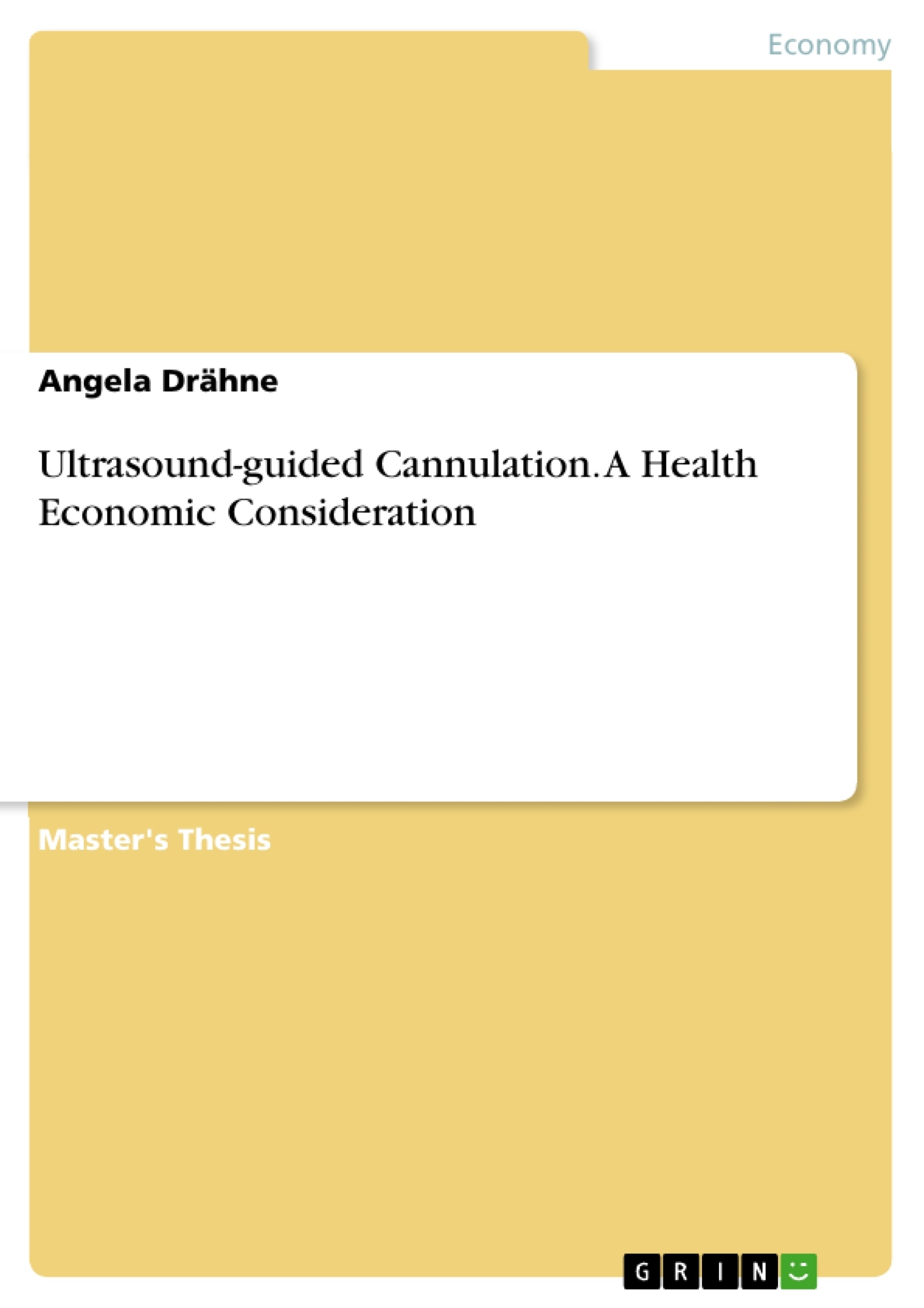In February 2016, approximately 100,000 people in Germany were affected by chronic kidney disease. 80,000 people in a dialysis program and 20,000 in post-transplant care. The figures are based on projections of health insurance data.
95 % of the dialysis treatment is carried out in a dialysis facility 3 times a week for 4 to 5 hours. A suitable vessel access/shunt is necessary to carry it through. As a "lifeline" and at the same time "Achilles heel" it influences the quality of dialysis and thus also the quality of life of chronically ill people. The access of first choice is an arterio-venous fistula (AVF), which is punctured 375 times a year during 3 dialysis treatments per week 2 punctures per dialysis treatment in 52 weeks per year. Mispunctures and additional dialysis were not considered.
Aim: The work examines the benefits of ultrasound-guided shunt puncture from the point of view of cost units and service providers. The following questions are to be answered:
1. Provides the use of ultrasound-guided shunt puncture for payers and for the in-dividual dialysis unit a concrete monetary benefit?
2. Is the acceptance of the shunt punctures by the patients with the use of ultra-sound technique improved?
3. Is the use of ultrasound technology associated with an improvement in puncture quality and a longer shunt survival?
Results: There are only a few studies on the use of ultrasonic controlled shunt puncture. None of the users has yet investigated and documented their benefits in a structured manner. The more than 10 years of experience of the team of the slide analysis facility of the Ev. Stift Koblenz under the leadership of Doctor Morgenstern and Doctor Kurb could be used for this work. The greatest monetary benefit results for the cost objects. Outpatient care and radiolog-ical interventions without inpatient admissions represent considerable savings potential.
From the perspective of nephrologists in private practice, additional costs are initially incurred for the acquisition of ultrasound technology and the further training of nursing staff. The introduction of ultrasound-assisted shunt puncture requires organizational and personal adjustments, which must be supported and supported by the medical directors of the dialysis facilities.
Inhaltsverzeichnis (Table of Contents)
- Introduction, Objective, Questions
- Introduction
- Objective
- Research questions
- Theoretical background
- Definitions
- Haemodialysis
- Classification of vascular access
- Ultrasound and doppler technology in medicine
- Historical development and technology of doppler sound
- Historical development
- Technology of ultrasound
- Empirical findings on ultrasound-guided venepuncture
- Methodical approach
- The use of ultrasound-guided shunt cannulation
- Economic evaluation of different types of care
- Costs and revenues in dialysis therapy
- Costs of therapy from payer's perspective
- Costs of therapy from hospital perspective
- Costs of therapy from dialysis centre perspective
- Opportunity costs of dialysis centres
- Revenue elements
- Revenue of hospitals
- Revenue of dialysis centres
- Cost-benefit analysis
- Cost-benefit analysis from payer's perspective
- Cost-benefit analysis from hospital perspective
- Cost-benefit analysis from dialysis centre perspective
- Expected outcome
- Use of ultrasound technology for payer and service providers
- Use of ultrasound technology from payer's perspective
- Use of ultrasound technology from hospital perspective
- Use of ultrasound technology from dialysis centre perspective
- Shunt cannulation, shunt survival and Quality of life
- Cannulation quality and shunt survival
- Quality of life
- Summery and reference to research questions
- Monetary benefit
- Acceptance by patients
- Cannulation quality and shunt survival
- Critical view and further research needs
Zielsetzung und Themenschwerpunkte (Objectives and Key Themes)
This master thesis aims to evaluate the health economics of ultrasound-guided cannulation for haemodialysis patients. It explores the costs and benefits of this procedure for various stakeholders, including payers, hospitals, and dialysis centres. The study also investigates the potential impact of ultrasound-guided cannulation on shunt survival, cannulation quality, and patient quality of life.
- Health economic evaluation of ultrasound-guided cannulation for haemodialysis patients
- Cost-benefit analysis from the perspectives of payers, hospitals, and dialysis centres
- Impact of ultrasound-guided cannulation on shunt survival and cannulation quality
- Patient acceptance and quality of life considerations
- Identification of research needs and future directions
Zusammenfassung der Kapitel (Chapter Summaries)
- Introduction, Objective, Questions: This chapter introduces the topic of ultrasound-guided cannulation for haemodialysis patients and outlines the objective and research questions of the study. It emphasizes the importance of efficient and safe vascular access for haemodialysis patients.
- Theoretical background: This chapter provides essential definitions related to haemodialysis, vascular access, and ultrasound technology. It reviews the historical development and current state of ultrasound technology in medicine.
- Methodical approach: This chapter describes the methodology used in the study, including the data sources, research methods, and analytical techniques employed to evaluate the health economics of ultrasound-guided cannulation.
- The use of ultrasound-guided shunt cannulation: This chapter delves into the practical aspects of ultrasound-guided cannulation, discussing its advantages and potential complications. It also examines the existing literature on the use of ultrasound technology for this procedure.
- Economic evaluation of different types of care: This chapter focuses on the economic analysis of ultrasound-guided cannulation, considering the costs and revenues associated with this procedure from different perspectives, including payers, hospitals, and dialysis centres.
- Expected outcome: This chapter explores the expected outcomes of using ultrasound technology for haemodialysis patients, considering factors such as cost-effectiveness, patient acceptance, and impact on shunt survival and quality of life.
Schlüsselwörter (Keywords)
The key terms and concepts of this master thesis include haemodialysis, vascular access, ultrasound-guided cannulation, health economics, cost-benefit analysis, shunt survival, cannulation quality, patient acceptance, and quality of life. The study also investigates the implications of ultrasound technology for various stakeholders involved in the care of haemodialysis patients, including payers, hospitals, and dialysis centres.
- Quote paper
- Angela Drähne (Author), 2017, Ultrasound-guided Cannulation. A Health Economic Consideration, Munich, GRIN Verlag, https://www.grin.com/document/436426



